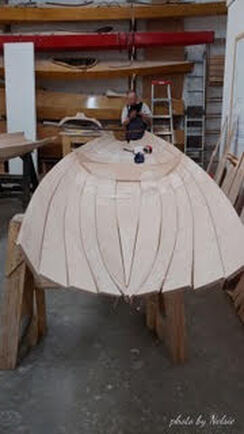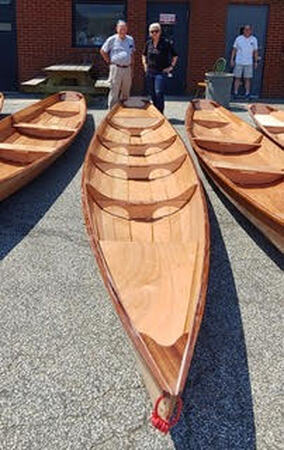|
This story is a guest post from Kingston resident and museum member and volunteer Nelsie Aybar-Grau of The Rondout Rower. We’re excited to share Nelsie’s experience building an Annapolis Wherry Tandem at Chesapeake Light Craft in Annapolis, MD. HRMM's Wooden Boat School offers boat building courses as well as introductory woodworking classes and wooden vessel restoration services. Boat building is a tradition with deep roots in the Hudson Valley’s harbors and ports and we thank Nelsie for sharing her story! Building Your Own Small Craft - Why I Built a Tandem WherryBy Nelsie Aybar-Grau Never in my life had I EVER thought I would build my own boat. If you would have told me that at the age of 72 I would build an Annapolis Wherry Tandem at Chesapeake Light Craft in Annapolis, MD, I would have told you that “you’ve lost your mind!” But that’s exactly what I did. In five days! (minus finishing which I am still doing now). It is a long road that led me to this. It started at the Hudson River Maritime Museum. When I was president of the Rondout Rowing Club I was asked to help out with the YouthBoat project where a group of students where taught woodworking skills. As part of the course we would take the students out on a traditional wooden boat, a Whitehall named John Magnus, so that they would learn to row a boat on the Rondout Creek. The John Magnus is a replica of the Whitehall design built by members of the Floating the Apple not-for-profit in New York City. Because of this I became interested in the very long history of the origins of the Whitehall. There is very little information on the Whitehall but I got my hands on a copy of the book Building Classic Small Craft (copyright 1977) by John Gardner which had a couple of chapters on it. It is believed that the basic design of the Whitehall was preceded by the Thames river wherries used by London watermen to provide taxi service. A Whitehall gig, which is the slightly longer version of the London wherry is 25 ft in length, requiring four rowers and a coxswain for a crew of five. For me, it resembled the “4+” crew boats that I used in the Rondout Rowing Club. When I began my own business of teaching sculling with my own crew training boats I found I needed a boat permitting two scullers (sculling is rowing with two oars, one in each hand). So I began looking everywhere for a modern wherry because I felt that it would be safe on the Hudson River as well as the Rondout Creek. I soon found that such a boat was out of my price range…… unless I built it myself. What I kept remembering was Gardner explained how boatbuilding in bygone years was done by everyone who needed a boat to do some sort of work on local waterways. Back in the day when there were no boat manufacturers people did what they could and over many, many years the designs improved until you had a boat like the wherry. It was famous for its speed and stability. “Fast, seaworthy, trim” and “reliable, expeditious” were terms frequently attributed to the wherry. Using Google, of course, I searched for a way to get my hands on a tandem (two seater) wherry and came upon the kits manufactured by Chesapeake Lightcraft in Annapolis, Maryland. They had a design they had been honing for 20 years. Their aim became to allow someone to build a boat in a week. Although not perfect, they worked hard at making sure that anyone with the least amount of experience could build a wherry with their kits in five days. A very ambitious plan and very well executed. The kit comes with a manual that one can follow individually or under the supervision of an instructor. The wood used in the kits is is plantation grown African marine plywood --- okoume, to be precise. The lightest weight plywood you can find. Not having a workshop AND not having the wherewithal to do this on my own I decided to go for the instructor-led course. Because I chose the tandem (double) and not the single, they told me I would have to have a partner. I had nobody to help me but on a whim I invited an old friend who I knew dabbled in woodworking, John Wilder. Neither of us were totally convinced we could actually do this, but if Chesapeake Light Craft did not balk at our skill level or our age, we figured we would take the plunge. It was a risk we wanted to take. And this was during the COVID pandemic! It’s pretty hot in Annapolis in the summer. In July it gets up into the 100+ temps and being in a workshop for 8 hours a day (minimum) was exhausting. It’s no small feat to build a boat in five days! We hit the ground running. As soon as we were given instructions we set to the tasks at hand each hour, each day, relentlessly. We did have a lunch break but pretty much we worked continuously. You really had to if you wanted to take that boat home on the final day! It was mind-boggling to watch the planks of wood we prepped and stitched together with copper wire become a navigable vessel. It went from looking like a Flamenco dancer’s fan to a trim boat within hours. I am not a very crafty person. OK, I had put together a piece of furniture or put up shelving in my house, but I did not know much about how to use a sander, a plane, a rasp…. The doing of it is the learning. By the end of the week I knew what “puzzle joints” are, what a scarf is, what “denatured alcohol” is (and the secret tip), how and when to sand, what level of grit paper to use, how to mix epoxy and hardener, when to use “fillet” (epoxy mixed with wood dust) or not, how to handle fiberglass. How to remove epoxy (note: epoxy cannot be removed, so don’t let it land on a spot you don’t want it to be unless you are committed to hours, no days!, of sanding.) Curiously (and somewhat disappointing) I have found that most rowers are not boat builders---they just want to row. And most boat builders are not rowers---they just want to build small craft.
In Kingston I think boat builders should learn to row and I think rowers should get into boat building ---especially since there are courses being given at the Hudson River Maritime Museum’s Wooden Boat School!
0 Comments
Your comment will be posted after it is approved.
Leave a Reply. |
Archives
July 2024
Categories
All
|
|
GET IN TOUCH
Hudson River Maritime Museum
50 Rondout Landing Kingston, NY 12401 845-338-0071 [email protected] Contact Us |
GET INVOLVED |
stay connected |






 RSS Feed
RSS Feed